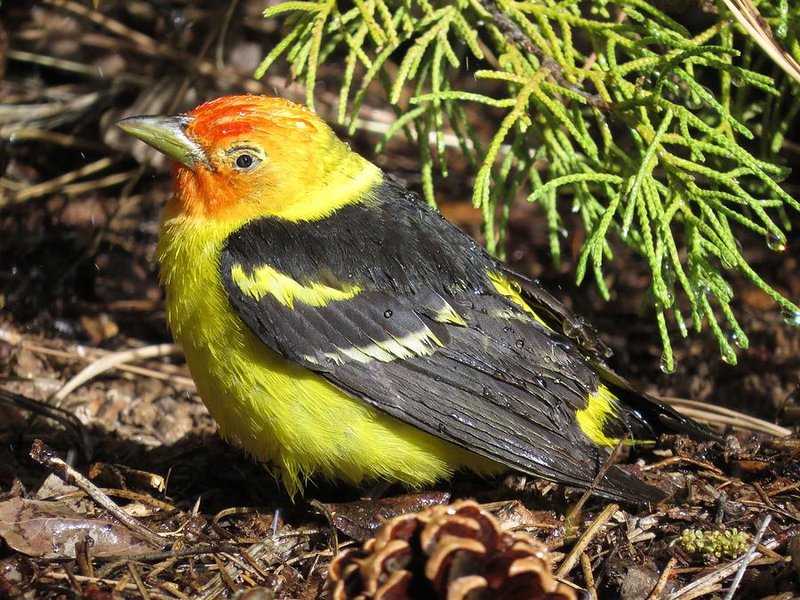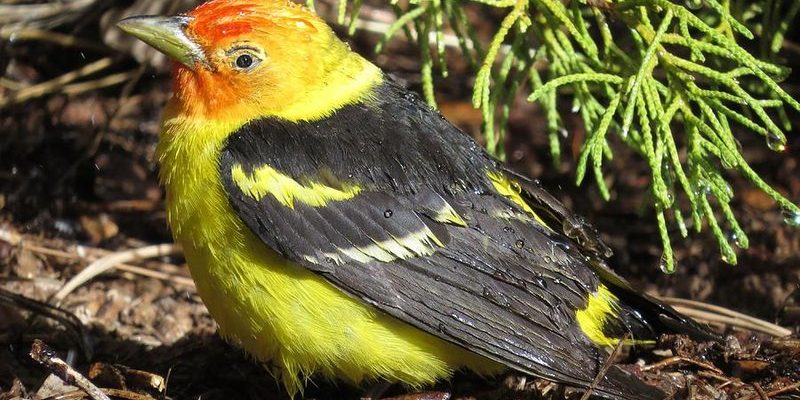
Imagine walking through a vibrant forest, sunlight streaming through the leaves, illuminating flashes of color—that’s the magic of tanagers. These birds are like jewels among the green foliage, each species boasting its own stunning palette. From the fiery reds and bright yellows to deep blues and greens, tanagers have captured the hearts of birdwatchers and nature lovers alike.
But tanagers aren’t just beautiful; they’re also fascinating creatures filled with unique behaviors and traits. You might be curious about where they live, what they eat, or how they interact with their environment. Let’s dive into the colorful world of tanagers and explore everything you need to know about these captivating birds.
What is a Tanager?
A tanager is a bird belonging to the family Thraupidae, primarily found in Central and South America, though some species extend into North America. These birds are part of a diverse group, with over 240 species classified as tanagers, varying significantly in color, size, and habitat. They are typically small to medium-sized birds, often well-recognized by their bright plumage.
The bright colors of tanagers serve multiple purposes, from attracting mates to signaling territory. You might notice that their vibrant hues can vary based on the species; some are bold and striking, while others display more muted tones. But it’s not just their looks; tanagers are also known for their melodious songs and vibrant behaviors. Their calls can fill a forest with sweet melodies, adding to the symphony of nature.
Habitat and Distribution
Habitat: Tanagers thrive in a variety of environments, but their preferred homes are tropical forests, woodlands, and shrubby areas. They are particularly fond of the rich biodiversity found in these ecosystems. While some species venture into subtropical climates, others are quite adaptable, making their homes in gardens and urban parks, provided there are enough trees and shrubs to shelter them.
One of the most interesting aspects of tanager habitats is their reliance on specific plant species for food. Their diet often consists of fruits, insects, and nectar. This means that the health of their habitat directly impacts their survival. Deforestation and habitat loss pose significant threats to many tanager species, making conservation efforts crucial.
Physical Characteristics
What really sets tanagers apart is their dazzling appearance. Most notably, their bright plumage can be a mix of vibrant reds, yellows, and blues, often with contrasting colors on their wings and tails. This brilliant coloration is not just for show; it plays an essential role in their courtship rituals. Males tend to have the most vivid colors, which they flaunt to attract females.
Furthermore, their size generally ranges from about 4 to 7 inches in length. This compact size allows tanagers to flit gracefully through trees and shrubs in search of food. Their beaks are strong and conical, perfectly adapted for their diet of fruits and insects. In fact, some species, like the Golden-hooded Tanager, are particularly adept at consuming nectar, making them important pollinators in their ecosystems.
Diet and Feeding Habits
Tanagers are omnivorous, meaning they eat both plants and animals. Their diet predominantly consists of fruits, which they love to feast on, especially berries. You might see them perched on branches, using their strong, conical beaks to extract the juicy pulp from fruit. Insects also make up a significant part of their diet, particularly during breeding season when they need extra protein to feed their young.
Interestingly, the feeding habits of tanagers can vary greatly among species. Some tanagers are known to visit flowers to drink nectar, while others may prefer foraging through leaf litter for insects. This flexibility in their diet is one of the reasons tanagers can thrive in diverse habitats. Their role as seed dispersers is vital for the health of many plant species, showcasing how interconnected their feeding habits are within their ecosystems.
Behavior and Social Structure
Tanagers are often seen in small flocks, especially when foraging for food. This social behavior not only helps them find food more efficiently but also provides safety in numbers from potential predators. You might notice them interacting with each other through chirps and other vocalizations, making their presence known in a lively manner.
During breeding season, things get a little more competitive. Males will often engage in displays of color and song to attract females. These displays can be quite elaborate, showcasing not just their beautiful plumage but also their fitness. Once they form a pair, they typically stay together for the breeding season and work as a team to raise their chicks.
Reproduction and Nesting
When it comes to reproduction, tanagers have some unique behaviors. Most species build their nests in trees or shrubs, often selecting locations that provide a bit of cover to protect their eggs from predators. The female usually handles the bulk of the nest-building, weaving together twigs, leaves, and grasses to create a snug home for her offspring.
The typical clutch size can range from two to five eggs, depending on the species. Incubation lasts about two weeks, during which the male may help guard the nest and bring food to the female. Once the eggs hatch, both parents often share the responsibility of feeding the chicks, ensuring they receive the nourishment needed to grow strong.
Conservation Status
Unfortunately, many tanager species are facing threats due to habitat loss, climate change, and other human activities. Deforestation for agriculture and urban development has narrowed their living spaces, making it difficult for them to find food and shelter. Some species are classified as endangered, highlighting the urgent need for conservation efforts.
Organizations and local communities are working tirelessly to protect their habitats and promote sustainable practices. By conserving their ecosystems, we not only protect tanagers but also the countless other species that share their home. Supporting these initiatives can help ensure that future generations will continue to enjoy the beauty and wonder of tanagers in the wild.
Interesting Facts About Tanagers
| Fact | Description |
| Species Count | Over 240 species of tanagers exist worldwide. |
| Colors | Tanagers come in a variety of colors, including bright reds, yellows, and blues. |
| Habitat | Primarily found in Central and South America, they thrive in tropical forests and woodlands. |
| Diet | Tanagers primarily eat fruits, insects, and nectar. |
| Nesting | They typically build their nests in trees or shrubs, using twigs and leaves. |
| Conservation | Many species are threatened by habitat loss and climate change. |
FAQ
What do tanagers look like?
Tanagers are known for their vibrant colors. Most species have bright plumage, with males typically being more colorful than females. For example, the Scarlet Tanager boasts a striking red body with black wings, while the Blue-gray Tanager features soft blue and gray tones. They are medium-sized birds, averaging between 4 to 7 inches in length.
How many types of tanagers are there?
There are over 240 species of tanagers, each with unique colors and behaviors. Some of the more well-known species include the Scarlet Tanager, Blue-gray Tanager, and Golden-hooded Tanager. These birds are part of the larger Thraupidae family, which showcases a incredible variety of shapes and colors.
Where do tanagers live?
Tanagers primarily inhabit tropical and subtropical regions, especially in Central and South America. Many species thrive in dense forests, while others adapt to gardens and urban areas with sufficient tree cover. Their habitat is crucial for their survival, as it provides food and nesting sites.
What do tanagers eat?
Tanagers are omnivorous, feeding predominantly on fruits, insects, and nectar. Their strong, conical beaks make it easy for them to extract juice from berries and other fruits. During breeding season, their diet may shift slightly to include more protein-rich insects to support their growing chicks.
How do tanagers mate?
During mating season, male tanagers display bright colors and sing to attract females. Once a pair forms, they work together on nest building and raising their young. Their bonding rituals can vary by species, with some engaging in intricate displays and vocalizations to secure their partnership.
Are tanagers social birds?
Yes, tanagers are generally social birds and can often be seen in small flocks, especially when foraging for food. They communicate with each other through various calls and songs, creating a lively atmosphere in their natural habitats. This social structure helps them stay safe from predators and locate food more effectively.
Why are tanagers important for their ecosystems?
Tanagers play a crucial role in their ecosystems as pollinators and seed dispersers. By feeding on fruits and nectar, they help plants reproduce and expand their ranges. This interconnection highlights the importance of preserving their habitats, as protecting tanagers also safeguards the wildlife and plant diversity that rely on them.
What threats do tanagers face?
Many tanager species face significant threats from habitat loss due to deforestation, climate change, and urban development. These factors limit their living spaces and food sources. Conservation efforts are essential to protect these beautiful birds and their habitats to ensure their survival for future generations.
Can I see tanagers in the wild?
Yes, you can see tanagers in various locations, especially in Central and South America. If you’re in regions with tropical forests or even some urban parks, keep an eye out for these colorful birds. They are easier to spot during the breeding season when their vibrant colors are on full display, and their songs fill the air.
How can I help tanagers and other birds?
You can help tanagers by supporting wildlife conservation efforts, planting native plants in your garden to provide food and shelter, and reducing pesticide use. Learning about and sharing information on bird conservation helps raise awareness of these beautiful creatures and encourages others to take action, too.

